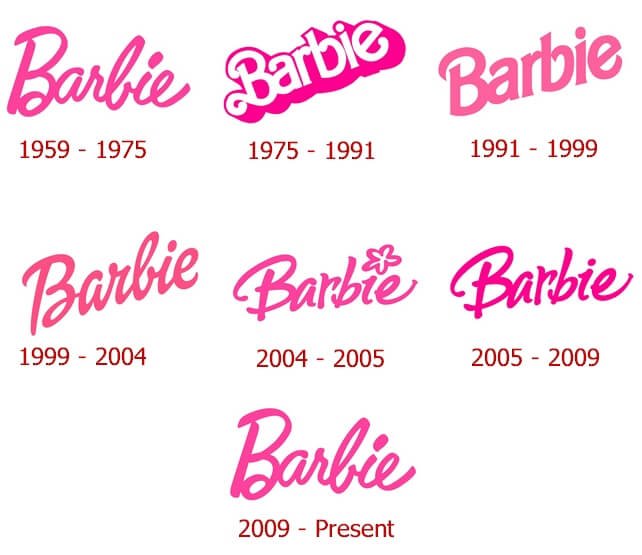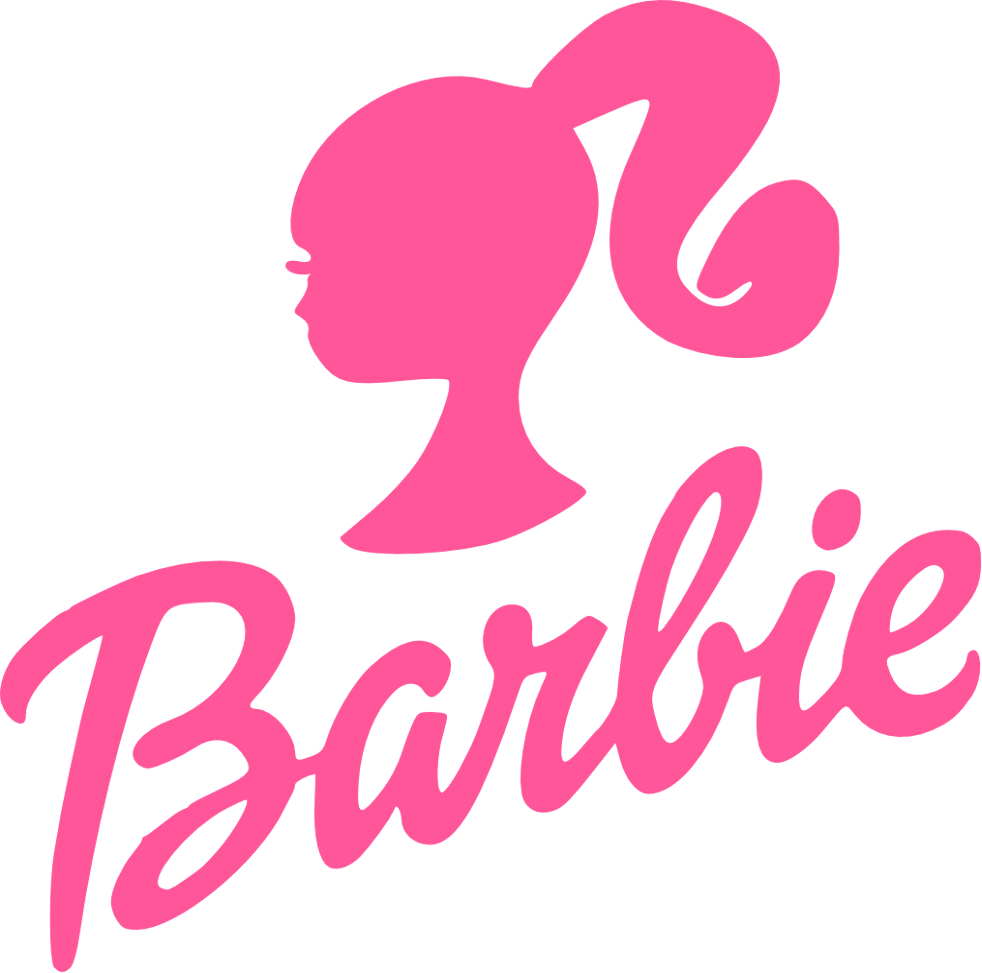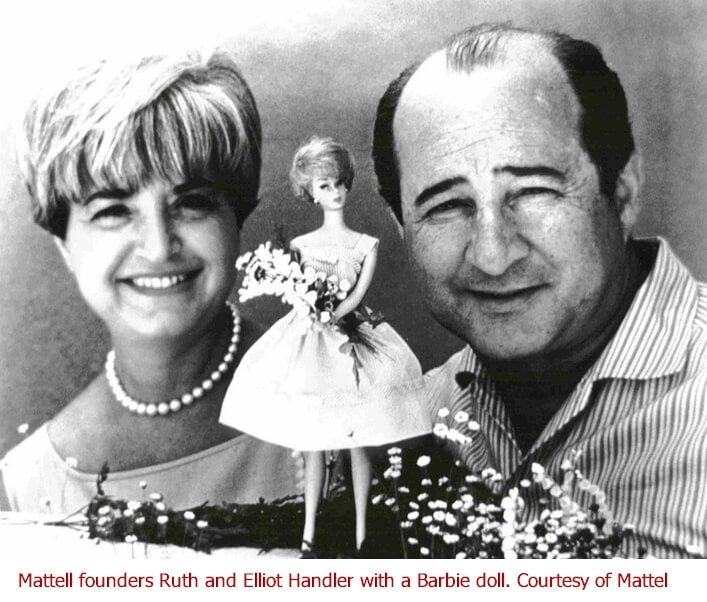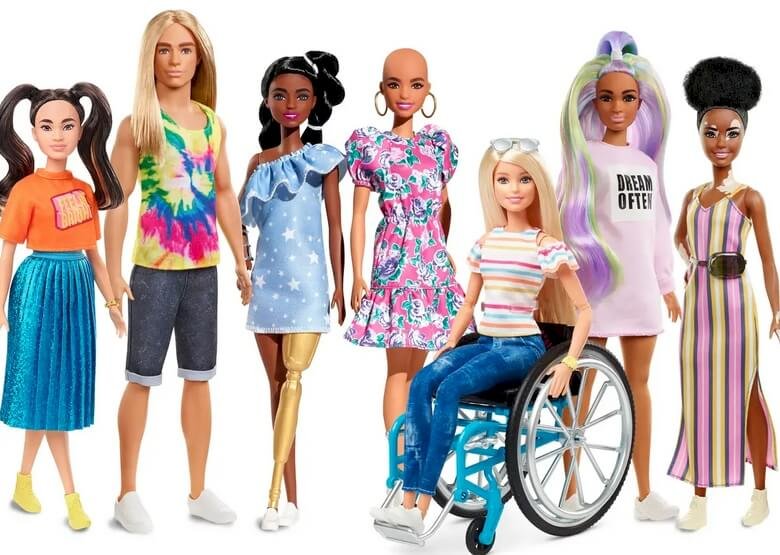The Barbie logo was created by Mattel Creations founders Elliot and Ruth Handler in 1959 when the “Barbie Doll” was created.
Mattel Creations co-founder Ruth Handler opted to design the doll after watching her daughter enjoy playing with paper dolls. After considering a number of designs and ideas, Ruth was finally inspired by a German doll named Bild Lilli, and Barbie was born on the 9th of March 1959. The first Barbie logo was written in a sans serif font when first introduced.
The popularity of the Barbie Doll has steadily grown, greatly aided by the logo. Even today, no matter the competition out there, it’s many people’s favorite print.
The Barbie logo is bright pink. This signature color was picked mostly to attract lasses to the Barbie brand. When combined with a typeface that resembles a kid’s handwriting, the logo communicates a sense of childhood, fun, and whimsy. While the Barbie symbol has changed quite a bit since its design in 1959, it has always been bright pink from the get-go.
The Barbie Logo Evolution

The Barbie logo is one of the few instances where a brand name brings back its original logo design after many redesigns. The logo had five major redesigns, but the company opted to go back to its roots in 2009, adopting the original fancy girly inscription as its official visual identity.
1959 — 1975
The first-ever Barbie logo was written in a slightly glamorous, child-like handwriting. The first letter, “B,” is written in uppercase, while the rest of the letters are in lowercase. The second “b” in the inscription is almost equal in height with the uppercase “B,” while the letters “e,” “r,” and “a” are smaller. The letter “i” looks slightly larger than “e,” “r,” and “a” and only slightly smaller than the second “b.”
The Barbie inscription has two standout features. The main highlight is the randomly arranged jumping letters. They’re totally different at the bottom and at the top, which makes the emblem look light and laid-back. This stylistic strategy communicates a lighthearted mood, airiness, charm, and naivety.
The second highlight is a curve at the uppercase “B.” Placed at the bottom, and the curl is directed inward, creating a mini oval.
1975 — 1991
The original Barbie logo was in use for around 16 years, making way for a new redesign. In a bid to modernize the Barbie brand name, the designers went for a 3D name. While the name was practical, it didn’t elicit a joyful atmosphere. The emphasis is mostly placed on the shadow and rigor that give the inscription a 3D effect.
The logo’s letters are all lowercase and have the same height, except the uppercase “B .” The letters are arranged somewhat linearly, while the line is flat. The inscription is placed diagonally, which dilutes its gravity.
This style communicates a sense of optimism and happiness. The “B” is the most unusual letter, comprising two stylish curls. The rest of the letters look elongated and broad due to massive shadows.
1991 — 1999
The designers opted to bring some cheerfulness to the Barbie logo for the sake of children. They made it simpler by getting rid of the huge features. The letters retained their shape, but the extra curls were removed from the uppercase “B.”
This logo design was considered much more intriguing despite the restrained style of writing. The height of lowercase letters “b” and “i” was almost the same.
1999 — 2004
The Barbie logo designers redesigned the inscription again in 1999. Therefore, the inscription was rendered in italics with a slight bend to the right. Moreover, the uppercase “B” got back its tiny inner curl, making it airy and stylish.
The brand name “Barbie” appears handwritten in one stroke, without breaking the bond between the letters. The logo is drawn with a reddish shade.
2004 — 2005

In 2004, the Barbie logo design was adjusted for the fourth time. The designers made the uppercase “B” bold and sweeping, so the bottom and top extend past the front legs. The characters are arranged differently and written without an inside connective, which makes the name appear galloping.
Lowercase “b” acquired a ponytail, while “i” got a five-petal flower instead of a dot. As such, the Barbie management team ensured that the inscription looked as childish as it could be.
2005 — 2009
After being in use for four years, the Barbie has transformed again: the flower made way for a classic dot. The letter “a” stayed unclosed, while the “e” had its leg elongated upward.
2009 — Today
Barbie brought back its original design of 1959, ensuring that all of the features remained unchanged. This idea portrays the Barbie symbol, style, and mood.
The Barbie Logo Design Elements

Font: The present Barbie logo design comprises a simple inscription featuring the brand’s name in a handwritten, italic font, which has a playful, elegant, and classic appearance and feel.
While the Barbie logo has undergone several changes since its introduction in 1959, the overall style has stayed the same for the most part.
Color: The Barbie brand has always been synonymous with Candy pink. The second version of 1975 had a slightly cooler pink shade than its predecessor. The color of the 1991 version looked more like the original version, but it was slightly lighter. Subsequent logo designs have had a more saturated shade of pink.
The History of Barbie

One day, Ruth Handler’s daughter Barbara was playing with paper dolls. Ruth noticed that Barbara usually gave the dolls adult roles. Most kid’s toy dolls were depictions of infants at the time.
Working out that there might be an opportunity on the market, Ruth pitched the idea of a grownup-looking doll to her spouse, Elliot, with whom she co-founded the Mattel Toy firm. He was lukewarm to the suggestion, as were the directors of the company.
In 1956, Ruth Handler toured Europe with her kids Barbara and Kenneth and came upon an adult-figured German toy named Bild Lilli. The doll was exactly what she had thought about, so she bought three pieces. She gave her daughter one of them and took the rest to Mattel.
Bild Lilli followed a popular character gracing a comic strip in the newspaper Bild. Bild Lilli was a beautiful working blonde who would stop at nothing to get what she wanted, even if it meant using men as means to an end. Bild Lilli was first available for sale in 1955 in Germany, and while it was sold to adults at first, it became a favorite of kids who liked dolling her up in clothes that were sold separately.
On her return to America, Handler remodeled the doll (assisted by local designer-inventor Jack Ryan) and renamed it Barbie, after her daughter Barbara. On the 9th of March 1959, the doll made its first appearance at the US International Toy Show in New York. Barbie also marks her birthday on this date.
The original Barbie doll was available either as a brunette or blonde and was dressed in a zebra-style black-and-white striped swimsuit and classic topknot ponytail. The doll was sold as “Teen Fashion Model,” with Mattel clothes designer Charlotte Johnson creating her outfits. The first dolls were made in Japan, with Japanese homeworkers hand-stitching their clothes. About 350,000 dolls were sold within their first year of manufacture.
In March 1961, Louis Marx & Company filed a lawsuit against Mattel. After Mattel licensed Lilli, Louis Marx & Company alleged that Mattel had “violated Greiner & Hausser’s trademark for Lilli doll’s hip joint, as well as claimed that Barbie doll was “an exact replica of Bild Lilli.”
In addition, the plaintiff claimed that Mattel “inaccurately and misleadingly claimed to have invented the design .” Mattel filed a counterclaim, and the two companies settled the case out of court two years later. In 1964, Mattel acquired Greiner & Hausser’s patent and copyright rights for Lilli for $21,600.
Ruth believed it was vital for Barbie to look like an adult, and initial market research indicated that some customers weren’t happy with the doll’s bust, which had distinctive breasts. The appearance of Barbie has been changed numerous times—not least in 1971 when Barbie’s eyes were tweaked to look forwards instead of the demure sideways look of the first-ever model. This was the last upgrade made on Ruth’s creation as, in 1974, she and her co-founder husband Elliot were ousted from their positions at Mattel following an investigation that found them at fault for releasing false reports.
Barbie became one of the original toys to get a marketing strategy modeled extensively around TV advertising, which other toys have since widely copied. It’s estimated that Barbie has sold more than 1 billion dolls all over the world in more than 150 countries, with the manufacturer claiming that every second sees three Barbie dolls sold.
Standard Barbie dolls are about 11 ½ inches tall, and the normal range of the dolls and associated accessories are produced to about 1/6 scale, also referred to as Playscale.
Appearances in Multimedia/Media Franchises

From the mid and late 1980s, Barbie products included a variety of dolls with their accessories and outfits and a huge variety of branded merchandise such as books, video games, apparel, and cosmetics.
Barbie doll had had a media/multimedia franchise since 2001 when she started appearing in a string of computer-animated movies under Barbie in the Nutcracker label. These movies have been distributed on direct-to-video/home video formats and on Blu-ray since 2013. They also aired on the US Nickelodeon cable network and its worldwide channels until 2017.
By 2013, Barbie’s direct-to-video movies had sold more than 110 million units globally. Before the movies, Barbie had two TV specials released in response to the increasing popularity of digital media in 1987. The doll also inspired a smash hit europop dance tune named “Barbie Girl” by Aqua in 1997.
In addition, Barbie doll was a supporting cast member of the TV series Kelly Dream Club, which broadcast in 2002, Pixar’s Toy Story movies—specifically its 2nd and three sequels, My Scene movies, and Dreamtopia, which follows the exploits of her younger sister Chelsea.
Competition
Other toy manufacturers have attempted to make dolls to provide competition for Barbie, but none have come close to challenging Barbie’s popularity. Some dolls were just likenesses of renowned celebrities at the time, including Cher and Farrah Fawcet.
In 1986, toy company Hasbro made one of the most popular competitors to Barbie dolls, named Jem, a female pop star who had a rock band of her own. At about the same time, the Barbie and the Rockers line of dolls was created by Mattel, with Barbie playing the role of a rock/pop singer.
Due to Mattel’s marketing power, Jem was outsold and driven out of the market soon after. In more recent times, Barbie has faced stiffer competition from the Monster High dolls, Disney’s Princesses, and Bratz doll line, with the brand even suffering decreases in doll sales.
Wrapping Up the History of Barbie
Barbie doll is a fashion adult-figured doll made by California-based giant toy manufacturer Mattel, Inc. It has been the most popular and best-selling brand of toys in the world since 1959. Barbie dolls are available in over 150 countries all over the world.
Renowned US businesswoman Ruth Handler created the Barbie doll in 1959, together with her husband, Elliot. She was got the idea from a German doll known as Bild Lilli and decided to name her creation Barbie, the short form of her daughter’s name Barbara.
Barbie doll has branched out to a media/multimedia franchise, like a long-running franchise of computer-animated movies that started in 2001. Between 2002 and 2007, the movies were regularly broadcast on the US Nickelodeon cable network.
Barbie dolls sales started to decline drastically between 2014 and 2016. In 2020, Barbie dolls and accessories worth $1.35 billion were sold by Mattel, and this was the company’s highest sales increase in 20 years.
Mattel has sold more than 1 billion Barbie dolls in more than 150 countries globally, making the doll the company’s most extensive and most lucrative product line.







